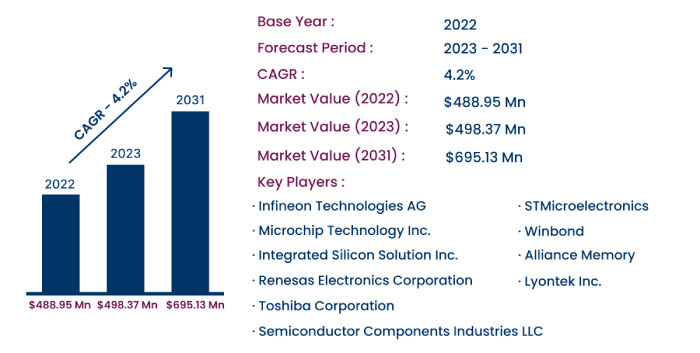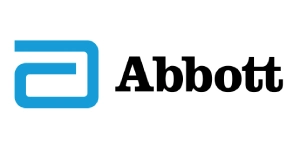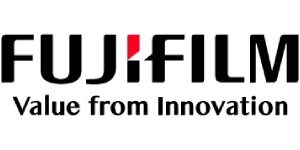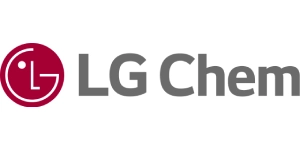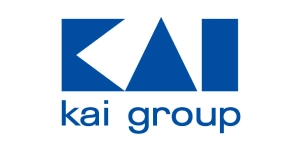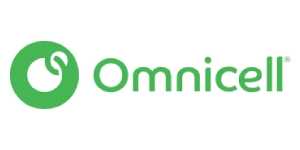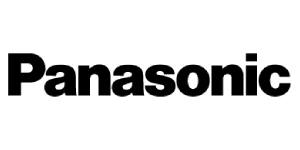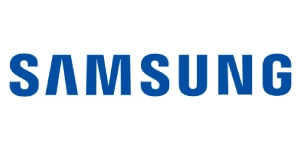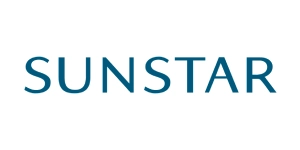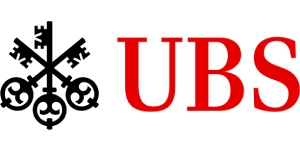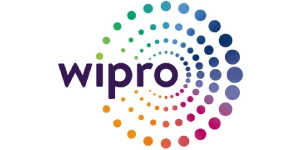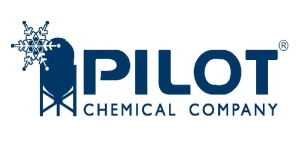Global Static Random Access Memory Market to Achieve CAGR of 4.2% By 2031 | CBI
Category : Semiconductor And Electronics | Published Date : Oct 2024 | Type : Press Release
Static Random Access Memory Market Scope & Overview:
Consegic Business Intelligence analyzes that Static Random Access Memory Market size was valued at USD 488.95 Million in 2022 and is projected to reach USD 695.13 Million by 2031, growing at a CAGR of 4.2% during the forecast period from 2023 to 2031. Static random access memory (SRAM) refers to a type of memory that retains data in a static form as long as power is supplied. It is characterized by faster operation, low power consumption, and low latency, making it ideal for applications in industries such as consumer electronics, automotive, telecommunications, and aerospace.
The report comprises the Static Random Access Memory Market Share, Size & Industry Analysis, By Type (Non-Volatile SRAM, Pseudo SRAM, Others), By Functionality (Asynchronous SRAM, Synchronous SRAM), By Sales Channel (Direct Sales, Distributor Sales), By End-User (Consumer Electronics, Automotive, Telecommunication, Aerospace & Defense, Others), By Region (North America, Europe, Asia-Pacific, Latin America, Middle East & Africa), and Forecast, 2023-2031.
The report contains detailed information on Static Random Access Memory Market Trends, Opportunities, Value, Growth Rate, Segmentation, Geographical Coverage, Company Profile, In-depth Expert Analysis, Revenue Forecast, Competitive Landscape, Growth Factors, Restraints or Challenges, Environment & Regulatory Landscape, PESTLE Analysis, PORTER Analysis, Key Technology Landscape, Value Chain Analysis, and Cost Analysis.
The rising demand for SRAM in consumer electronics, particularly for smartphones, wearables, and other consumer appliances, is a significant driver of the market. Additionally, the growing adoption of SRAM in automotive applications, such as ADAS and connected cars, is expected to provide substantial growth opportunities.
Segmental Analysis :
Based on type, the market is segmented into non-volatile SRAM, pseudo SRAM, and others.
- Non-volatile SRAM held the largest market share of 45.93% in 2022, driven by its ability to retain data without power and its use in consumer electronics, telecommunications, and industrial applications.
- Pseudo SRAM is expected to grow at the fastest rate, driven by its application in portable devices and wearables that require low power consumption and high performance.
Based on functionality, the market is divided into asynchronous SRAM and synchronous SRAM.
- Asynchronous SRAM accounted for the largest revenue share in 2022, benefiting from its low power consumption and reliability in automotive and industrial applications.
- Synchronous SRAM is projected to witness the fastest growth due to its higher speed and enhanced performance in data-intensive applications.
Based on sales channel, the market is bifurcated into direct sales and distributor sales.
- Distributor sales held the largest share in 2022, supported by the extensive availability of SRAM products through e-commerce platforms and regional distributors.
- The direct sales channel is expected to grow at the fastest rate due to the competitive pricing and personalized services offered by manufacturers through company-owned websites and outlets.
Based on end-user, the market is segmented into consumer electronics, automotive, telecommunication, aerospace & defense, and others.
- Consumer electronics accounted for the largest market share in 2022, driven by the growing penetration of smartphones, cameras, and wearable devices.
- The automotive sector is projected to grow at the fastest rate, driven by the increasing use of SRAM in advanced driver-assistance systems (ADAS), autonomous vehicles, and electric vehicles.
Based on regions, the global market is segmented into North America, Europe, Asia-Pacific, Middle East & Africa, and Latin America.
- North America held the largest market share in 2022, supported by advancements in telecommunications and aerospace industries in the region
- Asia-Pacific is expected to witness the fastest growth, driven by the expanding consumer electronics and automotive sectors in countries like China, Japan, and South Korea.
| Report Attributes | Report Details |
| Study Timeline | 2017-2031 |
| Market Size in 2031 | USD 695.13 Million |
| CAGR (2024-2031) | 4.2% |
| By Type | Non-Volatile SRAM, Pseudo SRAM, Others |
| By Functionality | Asynchronous SRAM, Synchronous SRAM |
| By Sales Channel | Direct Sales, Distributor Sales |
| By End-User | Consumer Electronics, Automotive, Telecommunication, Aerospace & Defense, Others |
| By Region | North America(U.S., Canada, Mexico) Europe(U.K., Germany, France, Spain, Italy, Russia, Benelux, Rest of Europe) APAC(China, South Korea, Japan, India, Australia, ASEAN, Rest of Asia-Pacific) Middle East & Africa(GCC, Turkey, South Africa, Rest of MEA) LATAM(Brazil, Argentina, Chile, Rest of LATAM) |
Top Key Players & Competitive Landscape :
The competitive landscape encompasses major innovators, aftermarket service providers, industry giants, and niche players, all of which are thoroughly examined by Consegic Business Intelligence in terms of their strengths, weaknesses, and value-addition potential. This report includes detailed profiles of key players, market share analysis, mergers and acquisitions, resulting market fragmentation, and emerging partnership trends and dynamics.
List of prominent players in the PVC-Free Packaging Industry:
- Infineon Technologies AG
- Microchip Technology Inc.
- Integrated Silicon Solution Inc.
- Winbond
- Toshiba Corporation
- STMicroelectronics
- Renesas Electronics Corporation
- Semiconductor Components Industries LLC
- Alliance Memory
- Lyontek Inc.
Recent Industry Developments :
- In March 2021, Infineon Technologies AG introduced a new non-volatile SRAM designed for high-reliability applications in aerospace and industrial sectors, promoting faster data access and improved performance.
